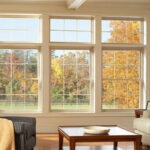The belief that a house with two main entrances promotes better air circulation and provides an additional escape route in case of emergencies is held by many. However, this concept is contradicted by the ancient principle of “multiple doors, multiple mouths,” suggesting that an abundance of doorways invites misfortune. So, is having two main doors in a house considered favorable or unfavorable?
Is it considered fortunate to have two main doors according to Feng Shui principles?
In the perspective of Feng Shui, a house with two primary entrances is considered taboo. Constructing numerous doors exposes the home to sunlight and wind from various directions, encompassing both positive and negative influences, ultimately disrupting the harmonious flow of energy. Furthermore, the multiplication of entryways poses challenges in maintaining security, compromising the safety of the inhabitants.

According to Feng Shui principles, a house with two main entrances is considered unfavorable.
Therefore, when constructing a house with multiple doors, it is imperative to establish a clear distinction between the main and secondary entrances. The door with the largest dimensions that facilitates convenient movement and transportation should be designated as the main entrance. On the other hand, the secondary doors, including the back door and side doors, should be treated as subordinate entryways.
For houses featuring one main door and one secondary door, careful consideration should be given to their arrangement. Firstly, it is essential to design them following the funnel principle, where the primary door is more expansive to invite positive energy (known as “vượng khí” in Vietnamese) into the house, while the smaller secondary door helps retain this energy. Avoid positioning the two doors in a straight line or allowing them to directly connect with each other. According to Feng Shui tenets, such an arrangement would result in the undesirable escape of positive energy, significantly impacting the family’s wealth, health, and finances.
Which doors are considered when a house has two entrances?
It is essential to distinguish between two scenarios when dealing with a house that has two entrances.
The first scenario involves a house with two primary doors, where both doors are identical in terms of functionality, dimensions, and design. In this case, it becomes challenging to determine which door should be considered the main entrance and which one the secondary.
In the second scenario, a house with two doors cannot be considered to have two main entrances if there is a clear distinction in size and functionality, clearly designating one as the main door and the other as the secondary.
Typically, the main door serves as the primary entry and exit point for all household members and guests. It is usually located along the main road and designed to be more prominent and aesthetically pleasing. However, in certain instances, the house may have multiple sides facing different roads, prompting the homeowner to add a smaller, secondary door to facilitate daily tasks and private activities. In such cases, having a main and secondary door within the same house is acceptable, provided it does not violate any fundamental principles of door placement.

A house with two identically designed main entrances presents challenges in determining their primary and secondary functions.
Contemporary Feng Shui Perspective on Houses with Two Main Entrances
According to contemporary Feng Shui principles, a house with two main entrances suggests disharmony among the family members. In households where relationships are strained, individuals tend to use separate doors to avoid awkward encounters, perpetuating and exacerbating the underlying conflicts.
Additionally, for smaller families or those without a dedicated security guard, the presence of multiple doors increases the risk of burglary and makes it easier for intruders to escape. Ultimately, the homeowners bear the brunt of these security breaches, suffering both financial losses and potential threats to their well-being. For these reasons, both ancient and contemporary wisdom advises against constructing houses with two main entrances.






































